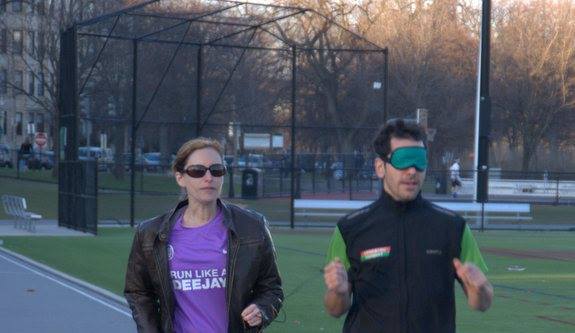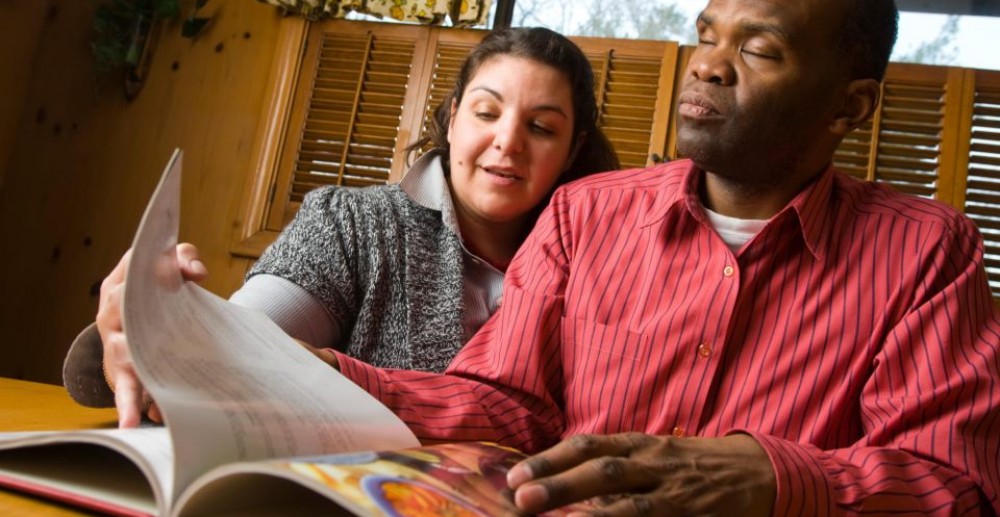Post by Elizabeth Mattey
Years ago if you had told me that I’d be running a mile blindfolded, let alone a 5K alongside thousands of other runners, I would not have believed it. “That’s terrifying,” I would have said. “How can you run without seeing where you’re going?”
Fast forward to today: I found a job working for the Massachusetts Association for the Blind and Visually Impaired, and for the first time in my life found myself working with and alongside visually impaired individuals everyday. I realized that these individuals could do pretty much anything a sighted person can do, if given the proper support: I met blind finance executives, lawyers, IT professionals and yes, even runners. I met people who’d lost their vision and then decided to run marathons and complete triathlons – if they could find great guides to be their “eyes” on the race course, then they could compete alongside the sighted athletes, no problem.
If they can do it, I thought, then why can’t I?
So I decided to do the Blindfold Challenge, an event co-sponsored by four Boston-area blindness organizations: the Carroll Center for the Blind, the Massachusetts Association for the Blind and Visually Impaired, National Braille Press, and Perkins. The Blindfold Challenge is to run a 5K race blindfolded, teamed up with a sighted guide, to simulate the experience of running blind. This year’s Blindfold Challenge was held at the B.A.A. 5K, located at the end of the historic Boston Marathon course, a sold out race at 10,000 runners.
I chose my boyfriend Giulio as my teammate, so for us the Blindfold Challenge doubled as both an exercise in teamwork and couples communication. Before race day we went to a training: my friend Joe Q., an NBP staff member who is visually impaired, trained us how to run as a blind/visually impaired runner-sighted guide team. Joe explained how to use a shoelace as a tether to connect the two runners, how to give verbal commands to guide the blind runner, how to navigate a race course without relying on sight. Giulio and I decided that each of us would practice being the blindfolded runner and the guide, since we each wanted to experience running blind.

It was time for us to practice running. First I guided Giulio, leading him around the track at Joe Moakley park, calling out when to turn left and right. Giulio was a natural, having little difficulty eliminating his vision and running ahead fearlessly. When it was my turn to don the blindfold, however, I was … pretty much a mess. The minute I started walking forward blindfolded, I realized I had no perception whatsoever where I was going. My usual lack of spatial perception can actually get worse – without my sight. Once my vision went dark, I started tuning in more accutely on my other senses: I became more focused on my hearing, feeling as if the sounds of the park around me were suddenly magnified, much closer to me. The sounds of the lacrosse game next to us became louder for me, disorienting.
“Are we going through the game?” I began to panic. Apparently running blind wasn’t easy at all.
“No, we’re still on the track – you have to trust me, Elizabeth!” Giulio replied. It all came down to that: trust. A blind athlete running the Boston Marathon has to put complete trust into his or her guide, relying on them to anticipate obstacles, lead to water if needed, basically ensure their safety on the course. So if we were going to be successful in the Blindfold Challenge, we were going to have to trust each other completely.
The morning of the race I woke up at dawn, my stomach doing flips in anticipation. We decided to run to the 5K course from our Cambridge apartment to warm up our muscles before the race and get in some last minute practice – after my disastrous reaction to being blindfolded at our training, Giulio figured I could use all the preparation I could get. As we ran alongside the Charles just after sunrise I began to relax, getting in to my stride.
When we arrived at the 5K start it was a madhouse – we crammed in the chute alongside thousands of other people. I knew that once the race started even with our bib with “guide” written in red letters, it was still going to be tough. I was running blindfolded first: we agreed to trade of at the halfway point on the course so we could each get the experience. The national anthem began and I knew it was time. I put on the blindfold.
We began to run – well, shuffle, at first – forward. Giulio led me through the crowd slowly, until finally we got out into enough space to run. I began to pick up my feet faster. One foot before the other, I told myself. Hold the tether. Follow Giulio. He will guide you. My eyes clenched shut underneath the blindfold, I tried to focus on my breathing and not the sounds of the race around us.
“We are turning left in 10 kilometers,” Giulio warned me, and I began to ease into the turn. I felt the tension of our tether tighten as he guided me along the course, I felt the ground beneath my feet and the wind in my ears. “Is this pace ok for you?” He asked me cautiously.
“I’m good,” I said, surprising myself. “Actually I can go even faster!” We began to pick up more speed, move from a jog into a run. I’m actually doing this! I’m running blindfolded!
“I have to admit, I am impressed you are doing so well,” Giulio remarked as we passed the first mile. “You are much better than the first time at the training.”
“I just needed the practice,” I said. “And I have a great guide.”
As we approached the underpass on Comm. Ave Giulio warned me that the ground was sloping downward. All around me runners began to whoop and cheer, their screams echoing off the cement walls of the cavern. For me the sound was jarring, disorienting, impossibly loud. I grabbed Giulio’s arm and he guided me through the chaos.
We were getting to the halfway point already. Time to switch. Quickly I took off the blindfold and handed it to him: now it was my turn to be the guide. As we came to the first turn I called out in anticipation, “we’re turning, stay close to me!” Now with the blindfold off I realized how close we were to so many other runners all around us.
A woman darted out directly in front of us, oblivious with her headphones on and paying no attention to our tether and guide bib. She jumped close in front of Giulio and he smacked into her.
Luckily she didn’t fall. “Blind runner!” I yelled, looking back as we passed her. “She just wasn’t paying attention, I’m sorry – it happened so quickly!” I pulled on the tether to keep him closer as we cut through the crowd. We turned on to Beacon Street and a lane of open space opened up. “We can pick up the pace!” I said, and Giulio happily began to run faster.
I could see the Marathon finish line up ahead of us, the bleachers set up, the overhang, the bright yellow painted “Finish” on the road before us. “We’re coming to the marathon finish line!” I told Giulio excitedly. Up ahead of us people were stopping to take pictures at the famous spot, which after last year’s bombings have become almost iconic. We were getting closer, I felt my heart leap into my throat. Would I tear up? Don’t get emotional and run Giulio into a pole or something. I had to keep it together, to keep guiding Giulio through the crowds.
When our feet touched down to cross the bold yellow line, I didn’t cry. Instead I let out a whoop of joy. “We just crossed!” I yelled to Giulio, and he put up his fist into the air. We barreled along ahead, running as fast as we could. Finally we’d reached the end of the course, and we slowed, back in the chute. Giulio took off the blindfold.
“You did it!” I said.
“We did it,” he replied.
We finished 5K in 30 minutes, a couple minutes slower than I would have had we not been running with the blindfold. Yet more than any other race that I’ve run, I felt an amazing sense of accomplishment: I had tested myself in a way that I once would have never thought possible, and proved that even I could do it. I experienced firsthand the challenges that blind individuals experience every day, and I have that much more respect – it’s not easy, in fact it’s hard work. But with the right support, anything is possible.


